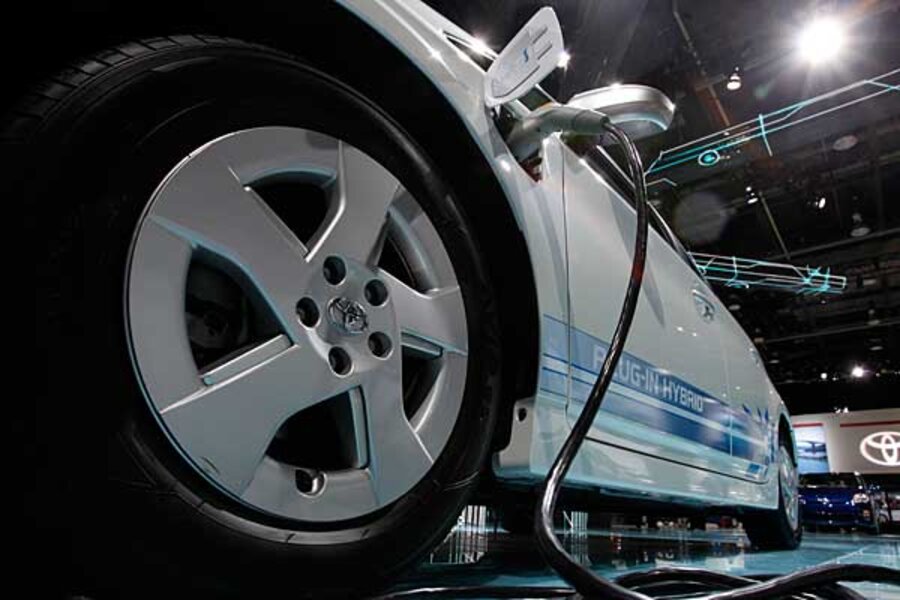Can California change US cars forever? New zero-emissions rules take aim.
Loading...
| Los Angeles
Confirming its role as a national trend-setter on auto emissions, California passed stringent new standards Friday intended to boost the production and sale of electric and hybrid vehicles here and nationwide.
The new rules passed by the California Air Resources Board (CARB) mandate that 15 percent of new cars sold in the state by 2025 run with zero emissions or near-zero emissions. The result would be some 1.4 million electric, plug-in hybrid, and hydrogen cars on California roads within 13 years. Today, there are 10,000 such vehicles in the state.
Critics such as auto dealers note that California has attempted to spur sales of zero-emissions vehicles before and failed. The current effort, they add, could also fail if zero-emissions vehicles remain so expensive that average car buyers cannot afford them.
But national carmakers have been largely supportive of CARB's efforts, and California's influence as the most populous state and a major car market could drive development of low- and zero-emission cars that echoes coast to coast.
“It’s definitely a big deal, very progressive and moving in the right direction,” says Nabil Nasr, director of the Center for Integrated Manufacturing Studies (CIMS) at Rochester Institute of Technology.
Environmentalists were understandably elated. In addition to the goals for zero-emission automobiles, the new CARB rules rein in emissions from conventional cars. By 2025, smog-producing pollutants must be cut by 75 percent and greenhouse-gas emissions by 50 percent compared with today's levels.
“This is a very powerful and history-making moment in which California is pushing the US and the world toward pollution-free cars,” says Vickie Patton, general counsel for the Environmental Defense Fund. “It’s a trifecta for America’s economy, competitiveness and security that depletes our dependence on foreign oil, protects human health, and saves families money during a devastating economic downturn.”
CARB's data suggest the move is a net positive for consumers. The board estimates that car prices will increase by as much as $1,900 because of the new rules, but consumers will save $6,000 in fuel costs over the life of the car by 2025, CARB estimates.
But auto dealers worry that the cost estimates are too low, and that the new rules could simply mandate the production of expensive cars that consumers won't have the money to buy.
At two days of public hearings in Los Angeles, several industry officials noted that back in 1990, California required that 10 percent of new cars sold in the state by 2003 be zero-emission. But battery technology didn’t develop fast enough, so consumers didn’t buy enough and CARB had to water down its mandate.
By making a law ahead of existing technology again , the cost of meeting the mandate could indeed drive costs up for consumers, says Dr. Nasr of CIMS.
“Hopefully the economy will do better and companies will invest in R&D to produce what is needed,” he says. “But if there are any glitches in funding or design with the needed technological advances, you might find a hiccup that will make this not very economical.”
CARB head Mary Nichols told reporters the rules include a midterm review in 2017-2018, in which car companies can present data on what consumers are buying, with the possibility that rules may be tweaked.
The oil industry, meanwhile, is concerned about mandates that will force some gas stations to offer hydrogen.
“We are OK with the idea of developing a non-mandated approach for small business owners who need some incentive to invest at the early stages of a new technology,” says Cathy Reheis-Boyd of Western States Petroleum Association.
But installing hydrogen-delivery technology costs about $1 million per station, and requiring 100 stations statewide to do it is too onerous. “We reject the idea of making them do it,” she says.
For their part, CARB members are encouraged by the support they have gotten from industry officials. Oil companies and the auto industry sued the state to stop the 1990 rules. This time, some asked for small tweaks but mentioned specifically that they agree with the overall goals.
“The most heartening aspect of this process is how far we’ve come.… The level of consensus is the highest I’ve ever seen,” she said.
Auto companies “have seen the handwriting on the wall," she said. "This really is a whole new chapter with the car in California, the US, and across the globe.”





